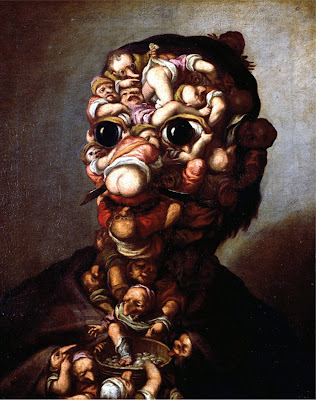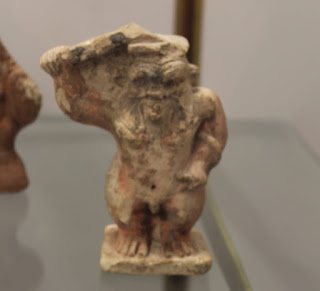 |
| Seneb and his wife Senetites (ca. 2520 BC) (Egyptian Museum, Cairo) |
People of (unusually) short stature1 are extremely popular in art: portrayal of people with so called ‘proportionate’ or ‘disproportionate’ short stature (usually achondroplasia) can be found all over the world and through the entire history of mankind. People of short stature were popular in ancient Roman and Greek art, but also in Asian, African and Latin American cultures. Fascinated by the tiny appearance of their fellow human beings, artists from Classical Antiquity till today liked to sculpt, cast, draw, paint, photograph or film people of short stature. Do these persons remind them (and us!) of ancient mythology about people of short stature living in faraway places? Do they attract us by their doll-like features? Are they funny, simply because they are smaller than ‘normal’ people? Some people consider them as more than funny, in their opinion they are ridiculous and for them they are a popular target to laugh with.
Without any doubt the Italian painter Faustino Bocchi (1652-1752) was one of history’s artists who was obsessed by people of short stature. Nevertheless, he is less famous than Diego Velázquez (1599-1660) who also made several beautiful paintings of the same subject (e.g. Las Meninas, 1653). Faustino Bocchi, who lived in Brescia, was specialized in painting people of short stature in ridiculous poses and situations. These paintings caused great amusement amongst his clients and made Bocchi a wealthy person. His tour de force, which was actually a shameless imitation of the works of Giuseppe Arcimboldo (1526/7-1593), is without any doubt the portrait of a human face, consisting of grotesque ‘pygmies’.
 |
| Faustino Bocchi, A Head formed out of Pygmies (1729) (Christie’s Images/Corbis) |
Today, looking at this painting, we can nod our head and condemn this painting of Bocchi, naming it ‘disrespectful’ towards a minority group, which is certainly a right attitude. On the other hand, Bocchi’s depiction of little people is only an exaggerated version of all other depictions of people with short stature in art around the world and throughout history. Almost always these people are portrayed with an emphasis on their tiny stature: they are shown with furniture, their protectors or benefactors (adult men and women or even children), various kinds of animals (parrots, dogs, monkeys,…) which make the contrast between big (normal?) and small even bigger. The animals on paintings with people of short stature seem to suggest that they were seen as nothing else than another kind of pet, meant to amuse their masters.
To my knowledge, there are almost no paintings or sculptures of people of short stature in a normal environment, where their size doesn’t matter. Almost always they are represented in art as utterly little, incredibly cute, unbelievably ugly, mysteriously strange or hilariously ridiculous. It seems like they don’t have no other function than to please and divert other people. Do they have a life outside of the painting? Do they have a wife? Do they have kids? Are they more than just people who are smaller than ‘normal’ people?
In that respect, the sculpture of Seneb and his wife Senetites, made by an unknown Egyptian artist around 2520 BC, is a unique depiction of a person of short stature. Seneb is portrayed in a very respectful manner, with his wife and children. Seneb is seated on the same height as his wife and because he crosses his legs while sitting, it can’t be seen, at first sight, that he is smaller than his wife. In this way, both are on ‘the same level’: they are equal in height and this might suggest a harmonious marriage as well. She is a beautiful woman and puts her arm around her husband in a very tender and loving way. The danger that the harmony – on the level of art and life - between this Egyptian man and his wife could be disturbed by the little legs of the husband, is avoided in a very intelligent way. The artist has replaced Seneb’s legs by two of the children of the couple, a boy and a girl. Seneb’s children serve as the legs of their father, but they are also the symbol of a successful marriage.
Seneb was a proud man, enjoying a happy life as a father, but also as a personal friend of the pharaoh. In the tomb of Seneb (near Cairo) about twenty of his royal titles can be found: friend of the Pharaoh, overseer of the dwarfs, overseer of the royal ships, overseer of the animal tenders, keeper of the seal of the gods,… Besides that Seneb and his wife were both important priests.
Why did Seneb obtain this prestigious position and why – as a consequence – was he depicted in the most respectful matter a person of short stature has ever been in history? Ancient Egyptians were very kind towards mentally and physically challenged people, but amongst them, people of short stature were the most respected. In ancient Egypt, at least two gods were venerated who had small stature: Bes and Ptah Pataikos. Bes was the god who protected women against evil, especially when they delivered babies. Ptah Pataikos, on the other side, was connected to Ptah, who was god of craftsmen and architects. Thus, both were very important gods.
 |
| Bes (3th-1st century BC) (Carlsberg Glyptotek, Copenhagen) |
 |
| Ptah-Pataikos (Late Period, 712-332 BC) (Carslberg Glytotek, Copenhagen) |
In their appearance, Bes and Ptah-Pataikos show typical characteristics of what is medically phrased as ‘achondroplasia’, the most common form of short stature. People of short stature, who are said to have achondroplasia, usually have a torso with ‘normal’ size, disproportionate small limbs with slightly curved legs and a large (fore)head. All these characteristics are prominently depicted in Ptah-Pataikos and Bes.
People of short stature reminded the ancient Egyptians about the scarab or Sacred scarab (scarabaeus sacer), a species of dung beetle which has a normal sized torso and tiny, disproportionate and curved limbs. This insect makes small balls of dung which he rolls out or towards his hiding place. This movement of rolling a ball out of a hiding place, reminded the ancient Egyptians about the movement of the rolling ball of the sun. In the eyes of the ancient Egyptians, people of short stature were not suffering from a physical challenge, but they were representatives of the gods here on earth. In this way, they deserved the highest respect!
Bert Gevaert obtained a PhD on the representations of disabilities in the epigrams of the Roman author Marcus Valerius Martialis (40-104 AD) (Free University of Brussels, 2013).
[1] For this text I preferred to use the term ‘people of short stature’ instead of other (combinations of) words, e.g. ‘little people’, ‘short people’, ‘small people’ or worse… ‘dwarf’. Though dwarfism refers to the medical condition of being unusually smaller than average (https://www.lpaonline.org/faq-) and some people of short stature have no problems with the word ‘dwarf’, the term ‘people (or person) of short stature’ is less biased and less insulting.↩
______________
______________
Recommended Citation:
Bert Gevaert (2018): People of short stature as representatives of the gods?. In: Public Disability History 3 (2018) 12.
Bert Gevaert (2018): People of short stature as representatives of the gods?. In: Public Disability History 3 (2018) 12.


